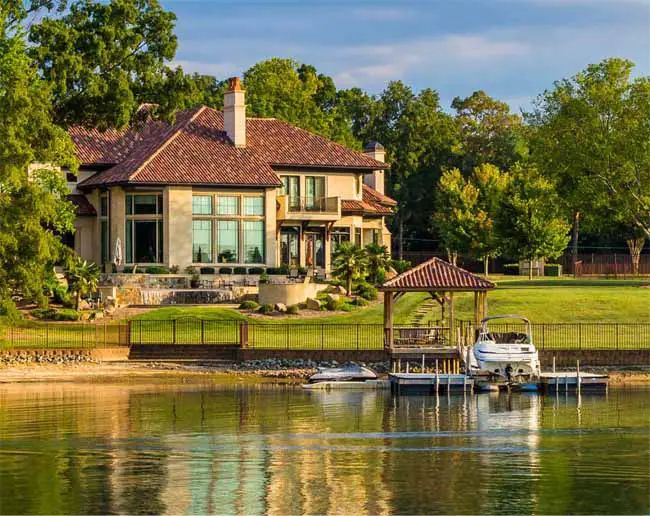A property line or property lines are essentially boundary lines. These are what are used when demarcating the area covered by a property. The issue of property lines can be complex and even contentious. At times it is easy because the property lines can be marked used physical and visible means. In some cases though, the property lines can be marked using intangible and invisible means. There are many things we can discuss on property lines; it is a loaded subject. Today, however, we are exploring the issue of, do property lines extend into the lake?
Table of Contents
Applicable Laws Can Be State-Specific Or County-Specific
Before we delve into our discussion it is vital to clear this. The issue of property lines extending into lakes (or not) can come to the fore in any state or county. There are laws that can be somewhat universal. Regardless, there can be laws that apply to one state or county and not the other. In light of everything you need to find out which laws apply to your location.
Of notable mention are local ordinances that might apply to a lake in question. Yes Riparian Rights often govern property lines dynamics for properties in front of lakes. However, the situation becomes different if there are local ordinances that apply to a lake. Typically, local ordinances stipulate on things like how the water should be used and by whom.
Understanding Riparian Rights
The concept of Riparian Rights serves as a useful guide. They help answer the question of whether or not property lines extend into the lake. Riparian Rights specifically apply only to lakes that are naturally occurring. When the lake(s) in question are manmade, Riparian Rights are not applicable. A Riparian right is the right of a person who owns land by a lake, river, stream, or creek to have access to and use the shore and water. They can use the water for fishing or agriculture but this is subject to laws which apply to a particular location.
In general terms, if you own a property with an inland lake front, your ownership extends to the shoreline and all the land that is submerged. The extent of the ownership usually ends at the center or middle of the lake. This refers to the water and under the water i.e. the lake bed. Remember that applies when the lake is naturally occurring. In fact, if you have a property in front of a naturally occurring lake, you are deemed a riparian owner.
NB: Riparian Rights do not apply to everywhere as is. In some places there can be variations or tweaks to them. In some places property lines do not even extend into the lake.
Notable Exceptions To The ‘Middle Of The Lake’ Boundary Rule
Then there are scenarios where the property’s upper land border is on a lake that can be navigated. This implies that the lake often has or can accommodate boats that transport freight. It does not matter this is something that happens seasonally or all year round. Provided there are no tides, the property line will extend to the lake’s edge – at the point of low water.
Tidal Considerations
Let us suppose that there are tidal waters involved. Let us consider your property’s upper land i.e. in relation to the lake. Upper land is land above the water. This can be a determinant in where the property line will extend. The property line will be at the point of high water. This is so provided that the property land borders with tidal waters. It is important to note though that tides might necessarily always apply to lakes. In principle, tides are often out of the picture when it comes to lakes. Regardless, aspects of tidal pull are at play in a lake; especially if it is significantly large.
NB: These exceptions are of course subject to what applies in a state or county. Just so you know, anywhere below or beyond the low water mark is normally considered public property. If you extend your property line into that region you will be trespassing.
Shape Of Lake Can Determine Extent Of Property Line
Often time lakes can generally be circular. When that is the case, property line extending to the middle of the lake usually applies. There can be cases when the lake is not circular-shaped. For instance, a lake can have an oblong shape. When that is the case, the extent of the property line might not be that obvious. It usually becomes necessary to engage professional surveyors to determine where the property lines extend to.
Ownership Of Or Property Rights Over An Entire Lake
It is possible that property lines can enclose an entire lake. This is only possible if the lake in question was constructed in its entirety on one’s property. It could also apply if a lake is contained within a property. A situation like this would mean that the property owner has total ownership of the lake. They can even erect a perimeter fence to ward off any unauthorised access. Anyone encroaching onto it or using it without permission would be guilty of trespassing. What would constitute the extent of the property lines would be the boundaries of the land submerged under the lake. That is unless there are no other local ordinances at play.
Conclusion
The issue of property lines for lake front properties can be complex. It is the bottom lands that are particularly difficult to determine where the property line extends. Bottom lands refer to the land below or submerged in the lake. At times this is so due to the fact that other people can be allowed to use part of what is ‘yours’. It is not uncommon to find many people confused by the subject. At least with lakes, it can be easier to enjoy substantial autonomy. If you are unsure you can consult property management experts e.g. surveyors. You can also engage legal experts or your respective local authorities to get guidance.

